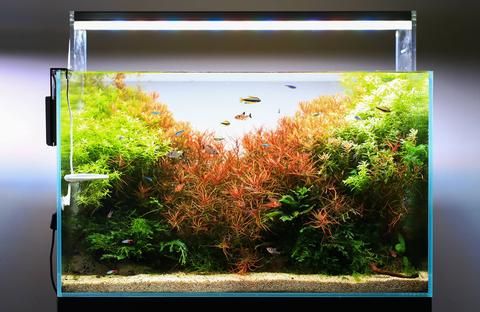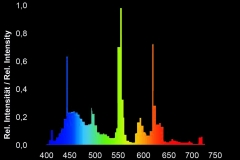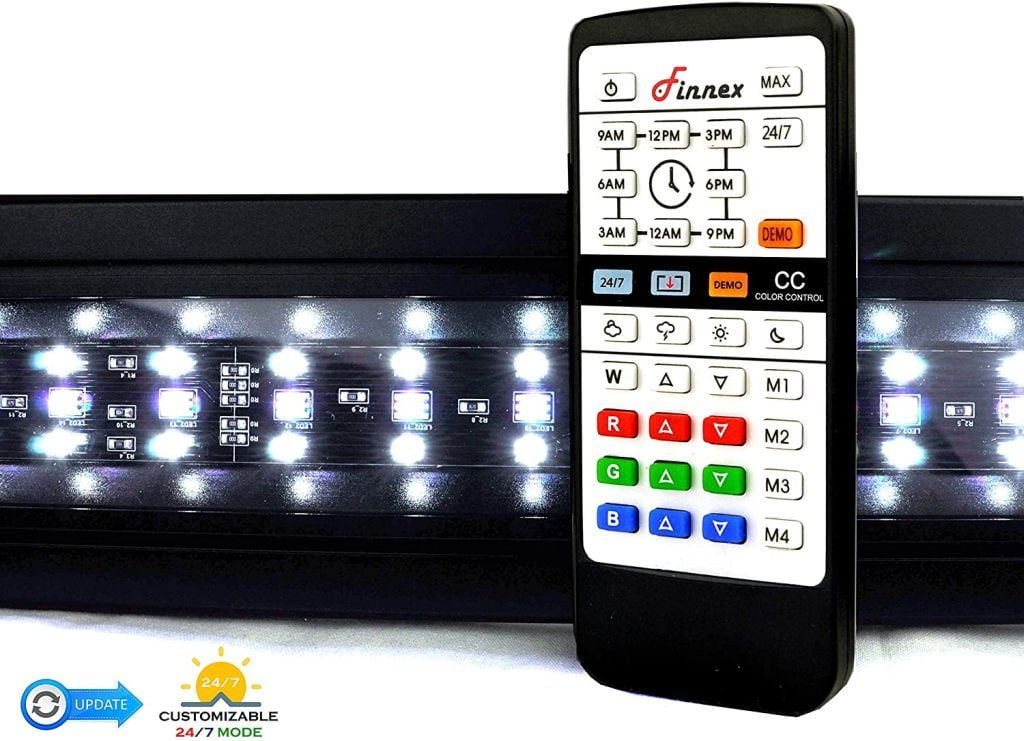Light in the Planted Aquarium
Plants do photosynthesis because it generates the food and energy. They need it for growth and cellular respiration. Without enough light, photosynthesis would be disturbed and plant health would decrease.
Arranging good conditions and light for aquatic plants is important for them to be to healthy and photosynthesize at an higher level. If you would like to plant an underwater garden forget about having just one fluorescent tube. It won’t live up requirements of many plants.
Before you will start looking forward to buy an aquarium lights I would recommend to get to know with the information, how plants use light in nature. Lighting aquarium is a key to proper aquatic plants growth.


Incorrect aquarium lighting may cause the growth of algae in the aquarium. Changing the intensity and time lighting in the planted aquarium can help to resolve the common problems caused by algae if the light has a right spectrum.
Dark green leaves means that a plant absorbs less green light from the light spectrum. It is like this because more green light is reflected from green surface. This plant has higher level of chlorophyll. Plant with dark green leaves is usually very hardy and is better adapted to low light conditions.
Red leaves plants are very similar like green it is just red light which the plant reflects the most. This spectrum of light is very important for photosynthesis. That is why those plants absorb more light from blue and green spectrum and reflects red more than absorb.
Some plants have ability to change the pigment used for photosynthesis depending on light conditions, that why some plants are turning green when there is not enough light and are more colorful when you are adding enough light.(in shortcut). Supplementing iron from the substrate or water column will slow down this transition process(from my understanding). Adding more iron will not turn plants red. It will only help them maintain this nice red color for a longer time. The light is the key in this situation.
Watts vs lumens
Aquarium lights use watts to produce light and its efficiency is called lumens per watt. Not always the most efficient light source is the best one. For example, in order to add enough light to larger and deeper aquarium, you would have to add many fluorescent tubes to produce enough output – lumens. In this case it would be better to use stronger unit like metal halide light or stronger 3 W each led bulbs in 300 W fixture.
Those lights (metal halide – not LED) produce more heat and are less efficient than fluorescent light, but it gives much higher light output and lightning intensity(lumens). Prices for this kind of lamps are quite expensive, but you would have to spend much more if you would like to get the same light output. Have in mind that metal halide lights for some plants might be also too strong in the aquariums more shallow than 16-18 inches, but you can always hang it higher if you need to.
Light Output
Lux – a measure of lumens per square meter. If you will include losses of the light during your calculations, it is very possible that you will provide great amount of illumination for your plants. Generally a regular planted aquarium will require around 30-50 lumens per liter of water(1 gallon-3.785 liters).
How much light is enough for plants? That all depends upon which plants you have chosen for your aquarium. If you have chosen nothing but “Easy” plants, 10-20 lumen (0.25 to 0.5 watts) per liter is adequate. For “Medium” plants, we recommend 20-40 lumen (0.5 to 1 watts) per litre, while “Advanced” plants require more than 40 lumens (1 watt) per liter.
Light spectrum
Wavelengths of light are usually measured in nanometers (nm) – billionths of a meter.‘Sunlight peaks in 430-440nm the blue area of the spectrum. This short waves length is used by both plants and algae. Green light is reflected by the majority of plants. Aquatic plants’ photosynthetic ability is most sensitive to long waves red light between 650 and 680 nm. Light in the infrared area (700-750 nm) cannot be used by plants.’
The light that the human eye can see ranges between 380 and 700 nm and is called the visible spectrum. At the “short” end of the visible spectrum is ultraviolet (UV) light with a wavelength of between 300 and 350 nm and at the “long” end is infrared light (700-750 nm) – useless for a plants
Light in nature
You may find aquatic plants in many freshwater lakes, rivers, waterfalls etc. In nature there are many light stages during the day, depending also on the plants location in the river and the weather. Plants addicted to open areas will require stronger lights for longer time. Some plants are growing above the water to gather more light and co2.
Light duration
Most tropical plants get about 12 hours of daylight with 10 hours of full darkness and this might be different in a different time of the year. It is important to make sure that plants in the aquarium get a similar amount of light.
Use a timer to meake sure that lights are automatically switched off and on. In aquarium with more source of lights turn them on and off in a different time thru whole day, to better imitate of natural daylight cycle. It is good for plant and as well fish. Very important is the time where there is a full darkness, because then aquarium plants rest(respire).
Creating a siesta period Plants are able to regulate the rate of photosynthesis relatively easily, and quickly respond to changes in light conditions. In other words, they do not take long to warm up and start photosynthesizing once there is sufficient light.’ You can use this plants future to fight with algae or prevent them from growing. Most issues with algae is not constant co2 supply, too much fertilizers and lightning intensity and time.
‘If the aquarium get 5 hours of lighting followed by 2-3 hours of darkness and then another 5-6 hours of light, the plants will be relatively unaffected and receive enough light throughout the day, but algae growth rates will be significantly reduced and may even start to die back.’ However many people says that creating a siesta period is a little old fashioned way and some plants even need around 4-6 hours to fully wake up, so you may try to experience it on your own
Reducing light loss
Mainly using all kind of reflectors, getting rid of plastic covers, cleaning often glass canopy, and mounting lights on proper height may help reduce light loss. You need to remember than deeper the light needs to get into aquarium, the less light goes in the very bottom. Reflectors are very important and can help increase amount of lights even to 40%. Plastic may discolor the light and change its spectrum.
Changes light intensity
If the light is too weak or not proper, plants won’t make photosynthesis fast enough and algae will start growing. Also while there will be too much nutrients in the water. In to high lights plants won’t have a time to produce enough pigments to protect their leaves and will start burning or even dying. Plants need time to transition from less light to more light.
I experienced that even some low-lights plants like java fern and anubias might be fine in the more intensive light, but it needs time to get use to more light. So make it easy for them and don’t start with your lights on max. Leave yourself a time to observe the plants and adjust it during the time.
Choosing the correct aquarium light
When choosing the correct lighting for a particular system, the four main factors to consider are:
- Efficiency (output in relation to power consumption)
- Output/intensity
- Initial cost
- Light spectrum
Fluorescent lighting T5

Fluorescent tubes emit light by electrically charging a gas contained within the tube. The light produced by the gas is mostly in the invisible areas of the spectrum, but the fluorescent coating on the inside of the tube converts this into visible light.
By altering the chemical coating on the inside of the tube, the spectrum of light emitted can be changed, so fluorescent tubes can be designed for specific purposes and to emit specific colors. Fluorescent tubes designed for aquarium plant growth often produce a red-yellow or red- violet-blue color, which, although not ideal for plants, may give the aquarium a slightly weird look. To remedy this, full-spectrum tubes can be added to balance the color output.
Fluorescent tubes are/were the most commonly used method of lighting aquariums, mainly because: they are very efficient, use little electricity, and are relatively cheap when used in small numbers. Most fluorescent tubes will last up to two years before they start to flicker and eventually become useless.
T5 lights efficiency
However, their light output drops considerably within the first year of use, so the tubes become less effective and less useful for plants unless they are changed at least once a year (every 16 months…also depends how many hours a day were they used). Fluorescent tubes are by far the best lighting solution for smaller or shallow tanks, but for deeper or larger tanks or for plants that require intense lighting, there are other alternatives.
Fluorescent tubes can be adequately rated for most purposes by the wattage of the light tube rather than its output of light. In aquariums that are 15 in (38 cm) deep or less,use 1.5-2 watts of light for every 4 liters (about 1 gallon) of aquarium water.
I was able to grow majority of plants in just 3600 lumens 2x36W 6500k full spectrum ‘daylight’ in 18 inches deep 40g breeder with co2. In order to have faster and more bushy plant growth after a few months I added 2x96W high output 6500k full spectrum ‘daylight’ fixture, and this is when things started growing like crazy. If you would blast this much light from the beginning, most likely you would experience lots of algae issues. This way plants had time to grow roots and substrate to create beneficial bacteria colony spreading sources of ammonia to nitrates and nitrogen for the plants to grow better.
- Oddysea lights for planted aquarium 6500k tubes (45bucks for 3 ft light with 2x36W t5)
- Giessemann bulbs (considered one of the best)
Metal-halide lamps

Metal-halide, or halogen, lamps provide intense, high-output light via a tungsten filament. They are ideally suited to deeper aquariums, with a water depth of 24 in (60 cm) or more. Suspended at least 12 in (30 cm) above the aquarium to allow ample ventilation, a single unit will illuminate approximately 2 ft2 (1,800 cm2) of surface area. (An aquarium 24 in/60 cm long and 12 in/30 cm wide.) Halogen lights are usually available in 150-watt or
250-watt versions; a 150-watt light should provide a suitable output for most aquariums. (250-watt versions are better suited to marine invertebrate aquariums, where demand for light from corals is higher.) You may need more than one lamp for aquariums longer than 42 in (107 cm). Halogen lights are initially the most costly method of lighting, but provide the best output for demanding aquarium plants.
LED aquarium lights
Nowadays, it is easy to find many suitable LED grow lights for planted freshwater aquarium. Here are my best choices:
Here are a few of my favorite lighting set ups that specialize in plant growth:
Finnex Planted+ 24/7 Fully Automated Aquarium LED (medium intensity)

Ray2 Aquarium LED Daylight (Strong light output)

FugeRay Planted+ Aquarium Light Plus Moonlights (the best plants and fish colors)

Kessil A360(A160,A150,A80) WE Tuna Sun (good intensity and penetration, more forgiving)



Any regular LED 6.5W or small bulbs LED 3W with 6500k daylight will work very good too. You build the fixture for them or place them in a desk lamp. (cheap option still growing plants well)

Fluval 3.0 (you can adjust spectrums)

Twinstar (very good spectrum and intensity, mostly for rimless aquariums)


Fluval Nano LED with Bluetooth app
UNS Ultimate Nature Systems Titan 1 LED RGB Aquarium Light


ADA SOLAR RGB

LED lights commonly last 50,000 hours. Whats more is LED lights generate very little heat (usually, unless it is 3W bulb). LED lighting uses less power per lumen output when compared to other planted aquarium lighting types. This difference is changing according to a tank size and output needed. This means cheaper yearly lighting costs.






